
Paterson was named for William Paterson, a signer of the United States Constitution.

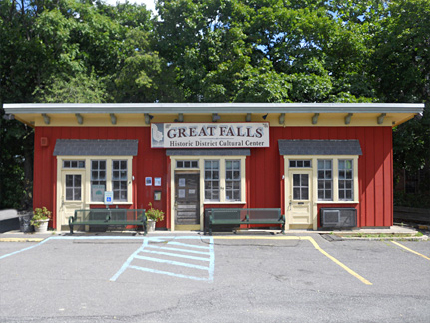
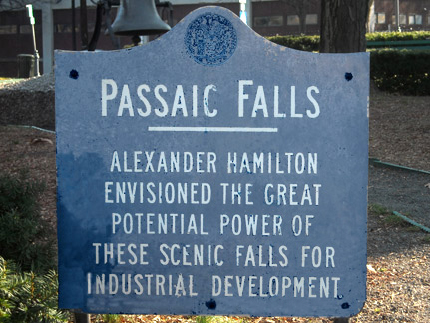
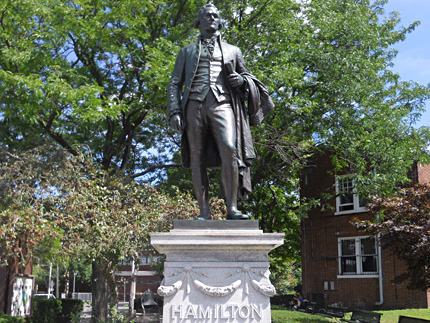
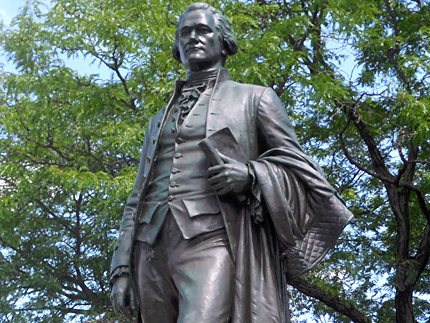
Paterson Great Falls National Historic Park
McBride Ave. and Spruce St.
Great Falls Historic District Cultural Center
65 McBride Ave.
Map / Directions to the Great Falls, and the Cultural Center
Map / Directions to all Paterson Revolutionary War Sites
For current hours and admission information, see:
Paterson Great Falls National Historic Park Website
Great Falls Historic District Cultural Center Website
George Washington, Lafayette, Alexander Hamilton and aide-de-camp James McHenry picnicked by the Great Falls during the Revolutionary War on July 10, 1778. Shortly afterward, McHenry wrote a picturesque account of the event:
"After viewing these falls we seated ourselves round the General under a large spreading oak within view of the spray and in hearing of the noise. A fine cool spring bub[b]led out most charmingly from the bottom of the tree. The travelling canteens were immediately emptied and a modest repast spread before us, of cold ham, tongue and some biscuit. With the assistance of a little spirit we composed some excellent grog. Then we chatted away a very cheerful half hour - and then took our leave of the friendly oak." [1]
After the Revolutionary War Hamilton went on to become President Washington's first Secretary of the Treasury. In that role in 1791, he helped establish the Society for Establishing Useful Manufactures, which founded Paterson as a manufacturing city, harnessing the power of the falls. [2] It was named for then-Governor of New Jersey, William Paterson, who had been one of four signers of the United States Constitution for New Jersey. [3]
A statue of Hamilton dramatically looks out over the falls, in tribute to our first Secretary of the Treasury. There are two other fine pieces of Alexander Hamilton sculpture/statues in New Jersey: one is in the Morristown Green, the other is at the site of Hamilton's fatal duel with Aaron Burr in Weehawken.
The falls can be visited during daylight hours, and a bridge allows visitors to walk out over the falls and look down on them. There is also the Great Falls Historic District Cultural Center, which serves as visitor center and small museum. Its hours and information are shown above.
The Paterson Falls are one of the most impressive spots in all of New Jersey, and they are well worth a trip!
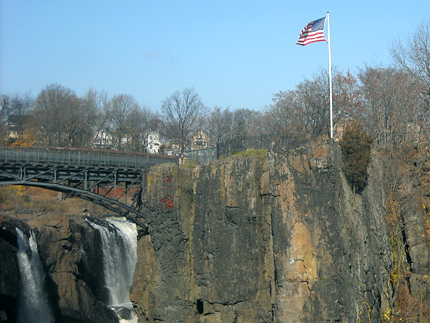
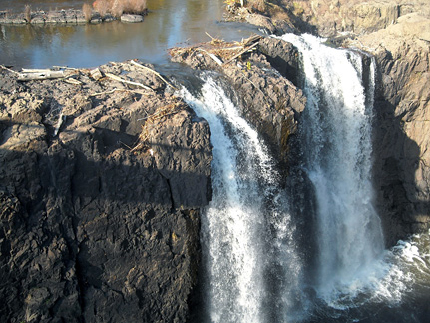
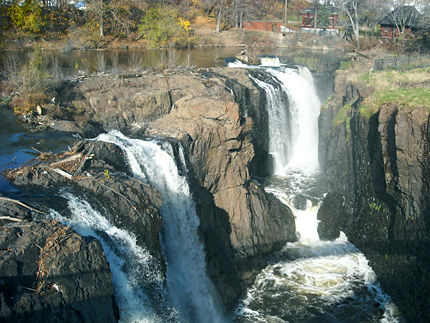
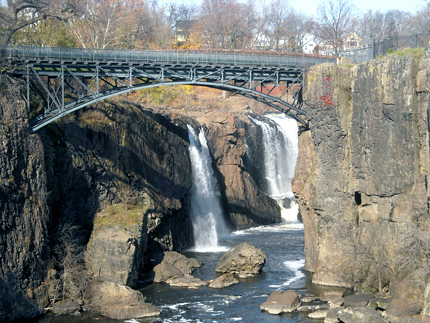

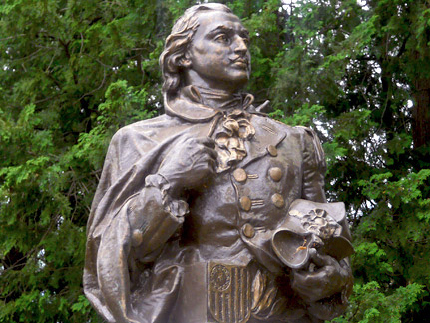
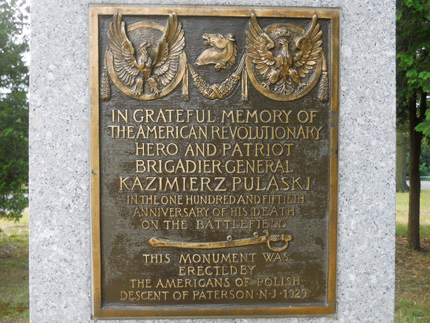
General Pulaski Monument
East Park Dr.
Inside East Side Park
Map / Directions to the General Pulaski Monument
Map / Directions to all Paterson Revolutionary War Sites
This impressive statue of General Casimir Pulaski inside Paterson's East Side Park was erected by the Americans of Polish Descent of Paterson, NJ, in 1929. The General's first name is usually spelled "Casimir" in the United States; here the Polish spelling "Kazimierz" is used. The plaque reads "In grateful memory of the American Revolutionary hero and patriot Brigadier-General Kazimierz Pulaski." [4]
Pulaski was born on March 6, 1745, in Warsaw, Poland. In 1777 he came to America to fight on the American side in the Revolutionary War. He commanded a group of cavalry which was formed in 1778 [5] known as Pulaski's Legion, and he is remembered as the "Father of American Cavalry." He died on October 11, 1779, from wounds suffered at the Battle of Savannah, Georgia.
There are three other monuments to General Pulaski is New Jersey, one in Garfield, one in Pennsauken, and one in Wallington. In addition to these, there is a sidewalk plaque in North Arlington honoring Pulaski, and the Pulaski Skyway is named for him.
In 2009 Pulaski was made an Honorary Citizen of the United States. [6] Honorary Citizenship has rarely been granted; only eight people in the entire history of the United States have received it. Two of the others who have received Honorary Citizenship were also European officers who fought for the American side in the Revolutionary War: Marquis Lafayette of France, and Bernardo de Gálvez of Spain. [7]

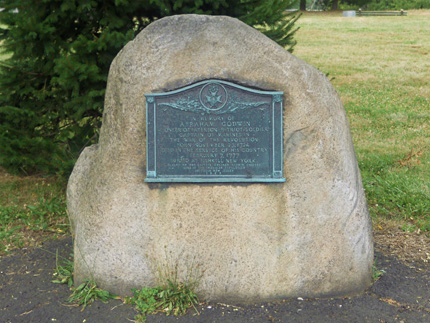
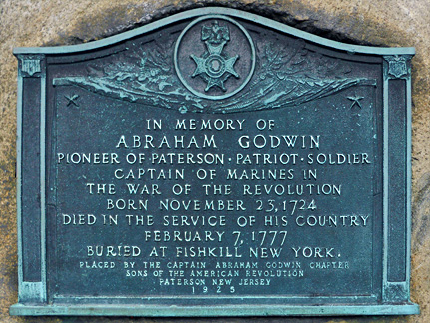
Abraham Godwin Monument
East Park Dr.
Inside East Side Park
Map / Directions to the Captain Abraham Godwin Monument
Map / Directions to all Paterson Revolutionary War Sites
A few yards away from the Pulaski Monument in East Side Park stands this small monument to Revolutionary War Captain Abraham Godwin. The plaque reads, "In memory of Abraham Godwin. Pioneer of Paterson • Patriot • Soldier • Captain of Marines in the War of the Revolution. Born November 23, 1724. Died in the service of his country February 7, 1777. Buried at Fishkill, New York." [8]
Abraham Godwin settled in what would later become Paterson in 1755; he purchased a plot of land that began about a mile west of the park on what is now East 18th Street and ran to the Passaic River. From north to south it went from roughly where 12th Ave to Broadway are now. In 1774 he built a tavern/hotel on his land, near the Passaic River, known as the Godwin House or Godwin Hotel (and later called the Passaic Hotel). [9] On Sept. 5, 1774, he ran the following newspaper advertisement: [10]
"The subscriber has lately built a new and very commodious house for tavern-keeping, about 200 yards from his late dwelling-house, at the foot of the bridge, and on the King's highway to Newark, and intends, God willing, to leave all business, as shop-keeping and farming, and to apply himself solely to tavern-keeping, and to keep as good a house as the country will afford, viz. Eating, drinking and lodging, with the best accommodations for horses. All gentlemen and ladies, who will please to favour him with their company, may depend upon the best and genteelest treatment. Should it appear too great a distance from his house to the falls, any gentlemen or ladies who chuse [sic] to go there shall be supplied with horses gratis.
By the public's most humble servant,
ABRAHAM GODWIN
Commonly called GORDON
N.B. A convenient room for dancing, and a fiddler, will always be ready for the services of ladies and gentlemen who may require it. Also a guide to attend any strangers, who shall shew [sic] them all the natural curiosities at the falls."
Eight months after this advertisement appeared, the Battles of Lexington and Concord, the first battles of the Revolutionary War, were fought in Massachusetts on April 19, 1775.

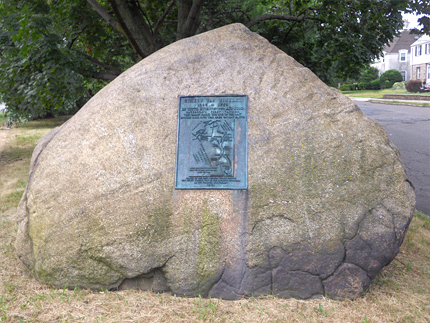
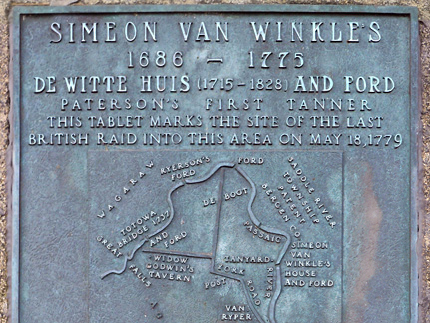
Last British Raid Monument
End of E. 42nd St.
~ Boulder is right alongside Rt.20, but E. 42nd St. does not actually connect with the highway.
From Park Ave., which does intersect with the highway, you can walk over to the spot.
Map / Directions to the Paterson Last British Raid Monument
Map / Directions to all Paterson Revolutionary War Sites
This boulder monument marks the location of land owned by Simeon Van Winkles, the first tanner in what would become Paterson. Along this area on the Passaic River was located his house and tannery, near a ford of the river. (A ford is a shallow area of a river, making it possible to walk or wade across.) His stone house, built here in 1715, was whitewashed; it was known as De Witte Huis (Dutch for 'The White House'). Simeon Van Winkles was born in 1686 and died in 1775; the house survived until 1828. [11]
The plaque, which was placed in 1961, also commemorates the last British raid into this area, which occurred on May 18, 1779. It includes a relief map of the area in 1779, based on a map by George Washington's Surveyor General, Robert Erskine, and British war maps of 1778. [12] The map includes houses and landmarks of the area at the time, including Simeon Van Winkles' property
This boulder monument is located on the end of E. 42nd Street, and it is visible to drivers passing by on Route 20.
Note that E. 42nd St. is a dead end off 17th Ave, and so does not connect with the highway.
From the Southbound side of Rt.20, you can turn right onto 17th, and then right on E. 42nd Street.
This boulder looks much more impressive in person than in the picture because it is hard to tell in a photo just how large the rock is. If you're driving by this on Rt. 20, it's certainly worth pulling off the highway for a minute to take a closer look. I personally very much appreciate the idea of standing in the 21st century in front of this huge rock which existed for eons that was used in 1961 to commemorate historical events from the 1700s.

1. ^ Bernard C. Steiner The Life and Correspondence of James McHenry (Cleveland; The Burrows Brothers Company 1907) p. 22
A digitized version of the book is available in Google Books here2. ^ Ron Chernow Alexander Hamilton (New York: The Penguin Group, 2004) p.192
3. ^ There were four signers for New Jersey. The other three were:
~ David Brearly (Buried at St. Michael's Episcopal Church in Trenton)
~ William Livingston. (Built and lived in Liberty Hall in Union, also lived in the Livingston-Benedict house in Parsippany)
~ Jonathan Dayton (Lived at Boxwood Hall in Elizabeth, and buried at St. John's Episcopal Cemetery in Elizabeth)
On the founding and naming of Paterson, see:
• John F. Snyder, The Story of New Jersey's Civil Boundaries: 1606-1968 (Trenton: Bureau of Geology and Topography, 1969) p. 210-211 Available as a PDF on the State of New Jersey website here.
• Origin of New Jersey Place Names (Originally compiled by the Federal Writers' Program of the Works Projects Administration in the State of New Jersey in the 1930s, and reissued by the New Jersey Public Library Commission in 1945) p. 25 Available as a PDF here.4. ^ Erected by the Americans of Polish Descent of Paterson NJ in 1929 (Noted on the plaque as "the one hundredth and fiftieth anniversary of his death on the battlefield")
5. ^ Continental Congress, Saturday, March 28, 1778:
Roscoe R. Hill, Editor, Journals of the Continental Congress, 1774-1789, Volume X. January 1 - May 1, 1778 (Washington D.C. : Government Printing Office, 1908) page 290
Available to be read at the Internet Archive here
6. ^ Congressional Record: Senate: Vol. 155, Part 5 (Washington D.C. : Government Printing Office, 2009) pages 6153 - 6154
Available to be read at Google Books here7. ^ The other five people who have been granted Honorary United States Citizenship are: Winston Churchill, Raoul Wallenberg, William and Hannah Callowhill Penn, and Mother Theresa. Only Winston Churchill and Mother Theresa received the Honorary Citizenship while they were alive. All others have received it posthumously.
See the document:
U.S. Department of State Foreign Affairs Manual Volume 7 – Consular Affairs / HONORARY CITIZENSHIP, which is available to be read on the U.S. State Department website here
▸ Note that Pulaski and de Gálvez are not listed in this document, because it was published in 2008, before either had been granted the honor.
• Pulaski was granted Honorary Citizenship in 2009 (See Source Note 6)
• Bernardo de Gálvez was granted Honorary Citizenship in 2014 (See H.J.Res.105 - Conferring honorary citizenship of the United States on Bernardo de Gálvez at the Library of Congress website here)8. ^ Plaque placed by the Captain Abraham Godwin Chapter of the Sons of the American Revolution in 1925
9. ^ Information about Godwin and the hotel was drawn from:
• E. M. Graf, "Totowa Bridge," Passaic County Historical Society Publication, April 1944 Available to be read in a condensed form at the Passaic County Historical Society website here
• "The Passaic Hotel," Bulletin of the Passaic County Historical Society, February 1953 Available to be read at the Passaic County Historical Society website here10. ^ The New-York Gazette: and Weekly Mercury, No. 1194, Sept. 5, 1774; reprinted in:
William Nelson, A. Van Doren Honeyman, Editors, Documents Relating to the Colonial History of the State of New Jersey, First Series, Volume XXIX (Paterson: The Call Printing and Publishing Co., 1917) p. 471 Available to be read at Google Books here11. ^ William Nelson and Charles Anthony Shriner, History of Paterson and Its Environs (the Silk City): Historical- Genealogical - Biographical, Volume 2 (New York and Chicago, Lewis Historical Publishing Company, 1920) p. 6-7 Available to be read at Google Books here
12. ^ Plaque placed by the Captain Abraham Godwin Chapter of the Sons of the American Revolution in 1961